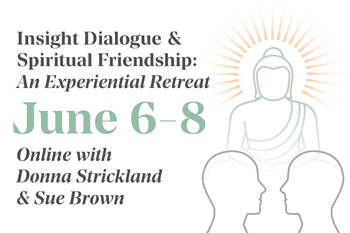By Donna Strickland

Almost twenty years ago, I took the leap to attend my first residential meditation retreat. Shortly after the retreat began, I found myself sitting face-to-face with a stranger, being asked to take in their presence, to pause, and to reflect out loud on the ways that I was currently experiencing dukkha, or stress, in my life.
To be honest, sitting with another person itself felt stressful. When I signed up for this Insight Dialogue retreat, I had not fully anticipated that it would actually involve dialogue–literally speaking and listening to another person. Even so, the interpersonal dimension of the retreat had not been lost on me. The flyer for the retreat quoted Gregory Kramer, the teacher and developer of Insight Dialogue, who noted that the first Noble Truth is the truth of suffering, and that much of our suffering is relational. Indeed! That statement got my attention.
And so here I was, in my first residential retreat, experiencing first hand a kind of relational suffering. The intensity of sitting so close to someone, looking directly into their eyes, and speaking deeply of my moment-to-moment experience felt unfamiliar and a bit uncomfortable. We had meditated silently as well, and we did throughout the retreat. But then there was this–the relational meditation practice that I was not sure I had signed up for.
But something miraculous happened over the course of that retreat. I learned to relax, to be fully present with another, and in that easeful, alert state, the two of us came to see more clearly together.
The miracle of Insight Dialogue is the miracle of Right View, the first factor of the Noble Eightfold Path, which is inherently relational. The Buddha taught that “there are two conditions for the arising of right view: the voice of another and appropriate attention” (MN 43).
Insight Dialogue offers a set of instructions for cultivating appropriate attention as we speak and as we listen. (You can find the instructions here.) And through taking in the voice of another who is deeply reflecting on the experience of Dhamma in their life–and speaking of it oneself—clear seeing arises.
Leigh Brasington, a meditation teacher well-known for offering instruction in the deep concentration states of jhana, has testified that he found Insight Dialogue to be an “amazingly effective way” to “step it up” in practice. He has noted that when practicing Insight Dialogue, “It just blew me away how readily the insights came and how deep they were. And most amazingly, all that talking-–deep, structured talking (not the usual chatter) —left me in a deeper state of concentration than on a traditional silent retreat” (Read more about Leigh.)
In other words, Insight Dialogue, like any meditation practice, is a vehicle for awakening—an opportunity to cultivate deep states of calm and deep insight. Sometimes there can be an assumption that Insight Dialogue is primarily about learning to communicate skillfully. To be sure, practicing Insight Dialogue has filtered into my daily interactions and supported Right Speech. But that is not the focus.
The focus is on using wise friendship—even if that friendship is with someone you have never met—as the vehicle for looking deeply into experience. Insight Dialogue, in other words, draws on the Buddha’s understanding that we are deeply relational creatures, and that our progress on the path requires others.
As the Buddha famously declared, “Admirable friendship, admirable companionship, admirable camaraderie is actually the whole of the holy life” (SN 45.2).
So what can you expect on an Insight Dialogue retreat? As in any meditation retreat, there will be periods of silent practice and periods of instruction. What is distinctive is the inclusion of periods of practicing and dialoguing together—most often in dyads, but sometimes in larger groups. These dialogues are guided by the teachers: you will be offered a specific contemplation to consider. Quite often, you will be taking turns so that the focus can be on either speaking or listening. In addition, the Insight Dialogue guidelines create a safe holding environment for the exploration, and we ask that everyone follow an ethical commitment to confidentiality.
After that first encounter with Insight Dialogue almost two decades ago, my world changed. I experienced the deep calm and steadiness that is possible while relating to another. (In fact, I became so committed to the practice of deep listening that I changed careers and became a therapist!) And that calm and steadiness enabled a level of clarity that I had never thought possible. I could not get enough. I looked for more and more opportunities to practice, and a couple of years later found myself at Southern Dharma Retreat Center, nestled up in the mountains of North Carolina. There I met my Dharma sister, Sue Brown, who will be leading this retreat with me. For the last twelve years, we have met weekly to practice together, and we look forward to inviting the retreat participants into the experience of spiritual friendship and the miracle of relationality.
Donna Strickland has practiced Insight Meditation since 2004. She has practiced Insight Dialogue since 2006, and has facilitated Insight Dialogue classes since 2011. She was formally recognized by the Insight Dialogue community as a teacher in 2024. Her full bio can be found here.
Sue Brown has been meditating in the vipassana tradition for 25 years, and fell in love with Insight Dialogue practice in 2006. ID has been her primary insight practice; Gregory Kramer, creator of ID, has been her primary teacher. Her full bio can be found here.
Donna and Sue will be leading an Insight Dialogue retreat, Insight Dialogue and Spiritual Friendship: An Experiential Retreat, online June 6-8, 2025. Registration is open. For more information and to register click here.